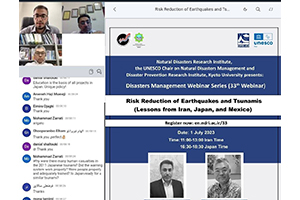
the 33rd webinar of the disasters management webinar series with the topic of "Risk reduction of earthquakes and tsunamis (Lessons from Iran, Japan, and Mexico)" was held on July 1, 2023, by the NDRI, UNESCO Chair on Natural Disasters Management and Disaster Prevention Research Institute (DPRI), the Kyoto University of Japan.
According to the public relations office of the Natural Disasters Research Institute (NDRI), the 33rd webinar of the disasters management webinar series with the topic of "Risk reduction of earthquakes and tsunamis (Lessons from Iran, Japan, and Mexico)" was held on July 1, 2023, by the NDRI, UNESCO Chair on Natural Disasters Management and Disaster Prevention Research Institute (DPRI), the Kyoto University of Japan with the registration of more than 600 officials, professors and individuals from Iran, Japan, Mexico, and India.
In this webinar, Dr. Yoshihiro Ito, Professor of the DPRI, and Dr. MohammadReza Ghayamghamian, Professor of the International Institute of Earthquake Engineering and Seismology presented their speeches.
Yoshihiro Ito initially noted the difference between slow earthquakes and normal earthquakes and highlighted the effects of the 2011 Tohoku earthquake and tsunami in Japan. Then he described the 8.2 magnitude earthquake and tsunami of 1932 in Jalisco, Mexico.
Moreover, he talked about the achievements of the SATREPS project on disaster mitigation in Mexico. The SATREPS project is a joint research project between Japan and developing countries to find a solution to reduce the risks and global warming. This project in Mexico aims to generate plausible earthquake and tsunami hazard maps built from accurate observational datasets for educational programs and activities to raise awareness of disaster mitigation and to generate tsunami evacuation maps and evacuation guide signs on the Pacific coast of Mexico. This project was carried out by three working groups monitoring, modeling, and evaluation. In this project, more than 2000 people could have been saved if the hotels joined the evacuation strategies.
The materials and programs are being implemented in a sustainable manner and all project outputs were shared with the municipality and state officials.
Then Ito answered the question, can we apply the same plan to Iran? In response, they mentioned that yes, the following can be addressed:
• Earthquake monitoring (including slow earthquakes)
• Modeling possible future large earthquakes
• Risk Assessment
The most important thing is strong collaboration in a team format, which includes monitoring, modeling, and risk assessment!
MohammadReza Ghayamghamian also pointed out that the main challenges in big cities and Tehran include: natural hazards (such as earthquakes, floods, etc.), man-made hazards (such as a fire), rapid urbanization, a tendency toward centralization, congestion, marginalization, and so on.
He also enumerated the steps to define a comprehensive action plan for disaster risk reduction and making resiliency. Then he discussed the earthquake history in Iran. In the following, methodologies and software in seismic risk estimation were mentioned. In addition, it addressed the benefits and stages of risk estimation. He pointed out that southern districts of Tehran are more exposed to risk based on studies. In the end, he introduced a new comprehensive method for seismic risk assessment using native parameters in Iran and seismic risk assessment using probabilities, scenarios, and Monte Carlo simulation.
At the end of the webinar, there was an opportunity for Q&A session from the participants, during which a discussion and exchange of opinions were formed around the issues raised.
All rights reserved for Natural Disasters Research Institute.
Design and developments by Armanic